ST2020 is a new portable spectrophotometer with 3nh own core research and development technology,Built-in large area silicon photodiode array (double row 20 groups) sensors, with excellent repeatability and inter-station differences, measuring data continued stable, accurate and reliable. The repeatability ΔE * AB of the array spectrometer ST2020 is easily controlled within 0.028, and the Inter-instrument Error ΔE * AB is controlled within 0.28. The measurement is accurate and can be used for accurate color analysis and transmission in the laboratory.
ST2020 array spectrometer with Φ8MM/φ10mm platform + Φ8MM/φ10mm sharp tip and 1*3MM/φ three measuring aperture, no matter the sample surface is regular flat or curved radian, can easily measure and get reliable and good repeatability data, in plastic electronics, paint coating, textile printing and dyeing, printing paper products, automotive, medical, cosmetics and food industries, scientific research institutions, laboratories are widely used.
Characteristics of the array spectrometer ST2020
1. Silicon photodiode array (20 double-row) sensors
The larger array sensor, the stronger light will not be saturated, the lower light sensitivity is higher and the wider spectrum response range, has guaranteed the instrument measurement speed, the accuracy, the stability and the consistency, grasps the core technology, with the same platform of international standards, achieve perfect compatibility.
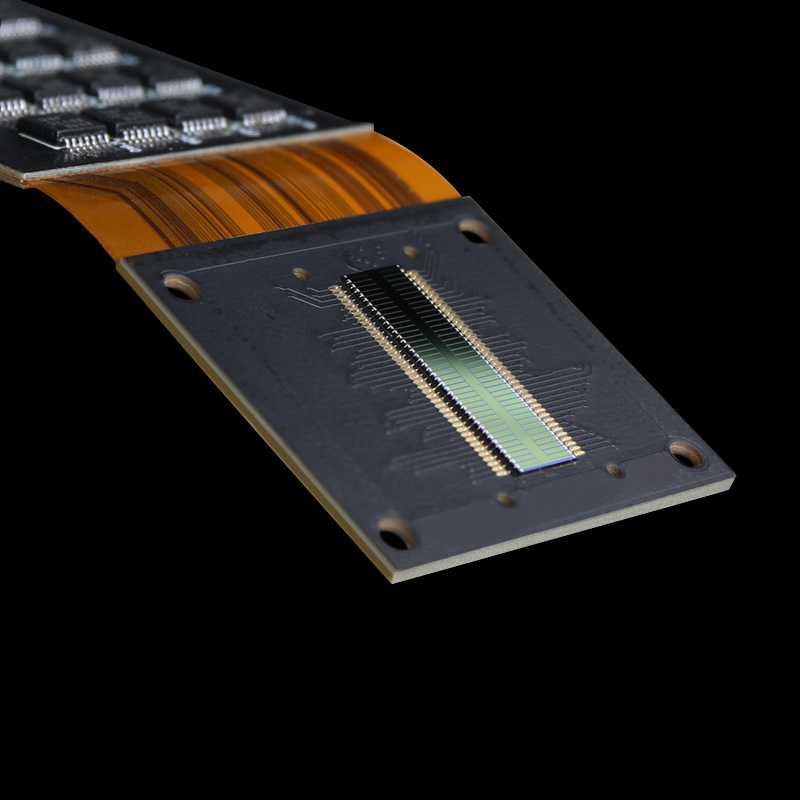
2、Adopt full waveband balanced LED light source
The array spectrometer ST2020 adopts 400 ~ 700nm full waveband balanced LED and UV light source as the illumination light source, which has enough spectrum distribution in the visible light range and avoids the loss of the spectrum of white LED in the specific wave band,Fluorescent materials can also be easily measured.
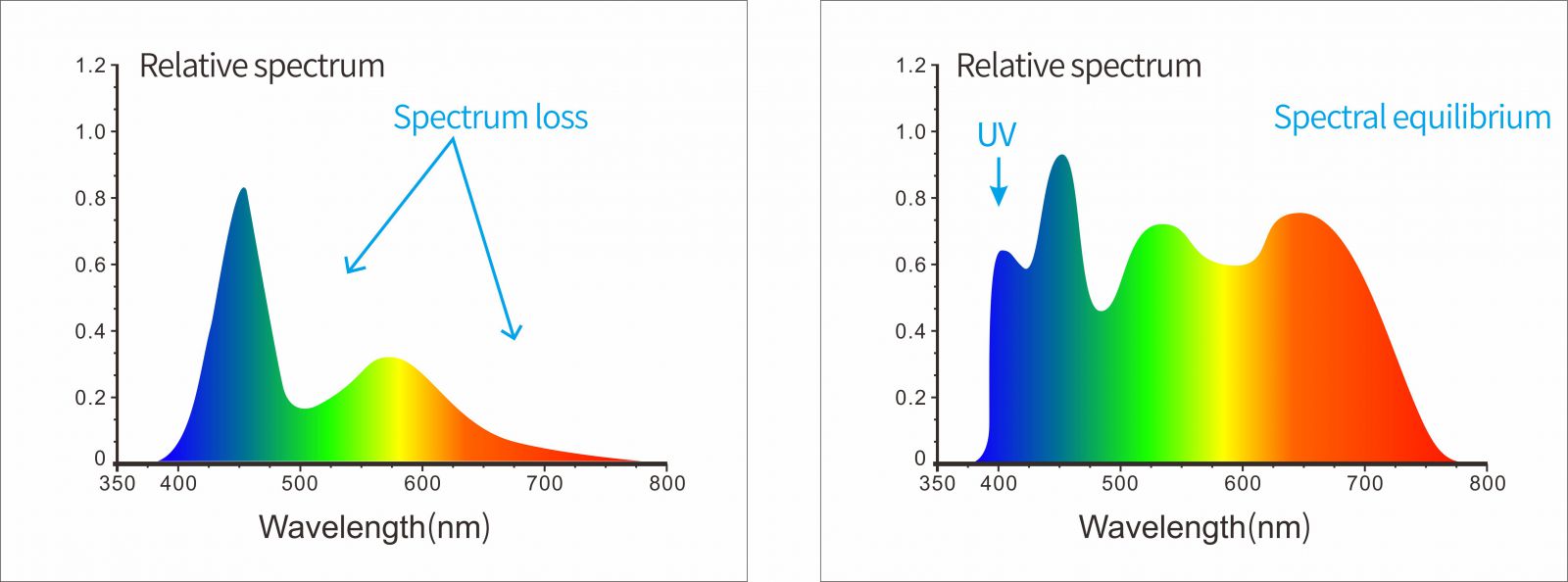
3、Grating splitting technology
The use of plane grating spectroscopy technology, with a higher resolution, so that more accurate color measurement.
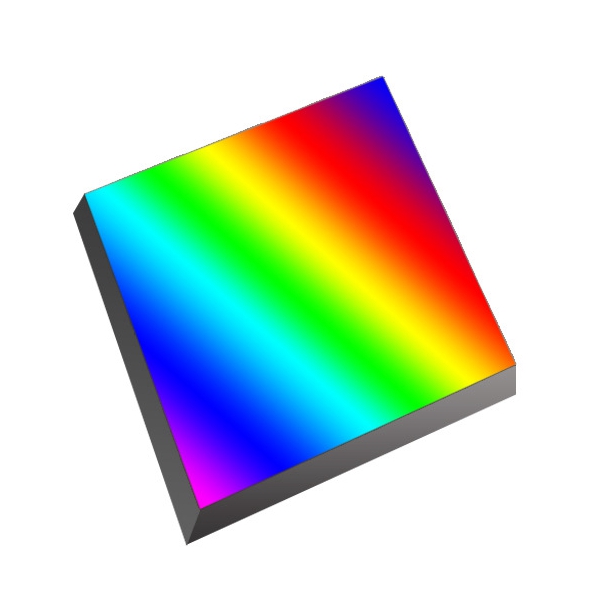
4、Intelligent base, automatic calibration
It is equipped with intelligent calibration base, can carry out automatic white board calibration, professional grade standard white board reflectivity R% ≥95% , good surface uniformity, high stability, can obtain repeated accurate data.
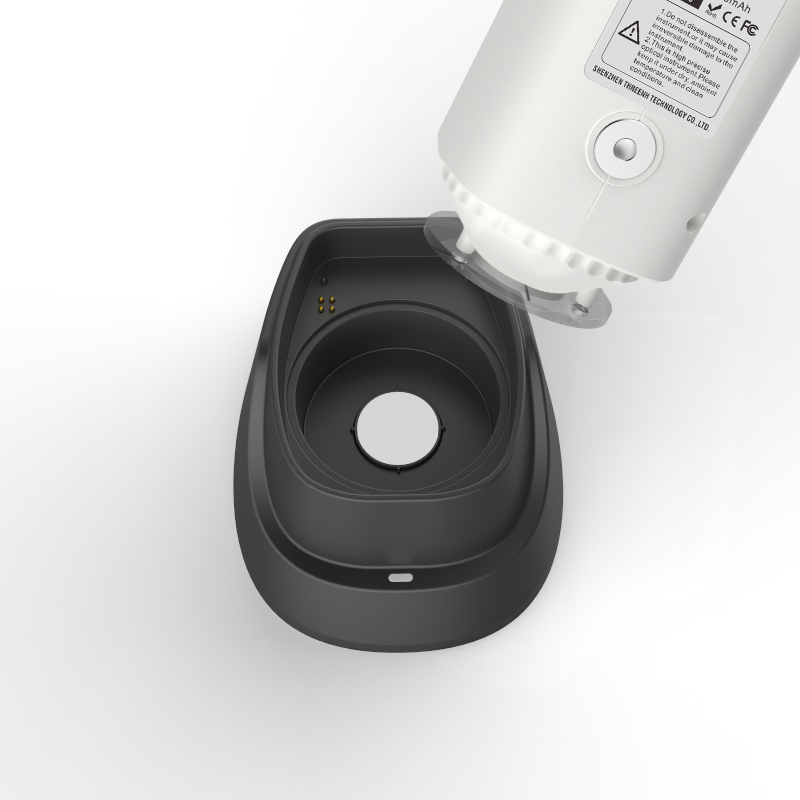
5、New fashion appearance design based on ergonomics
The hand-held position and the position of the measuring button are carefully designed to meet different holding habits, smooth and fine surface, derived from the professional appearance treatment technology.
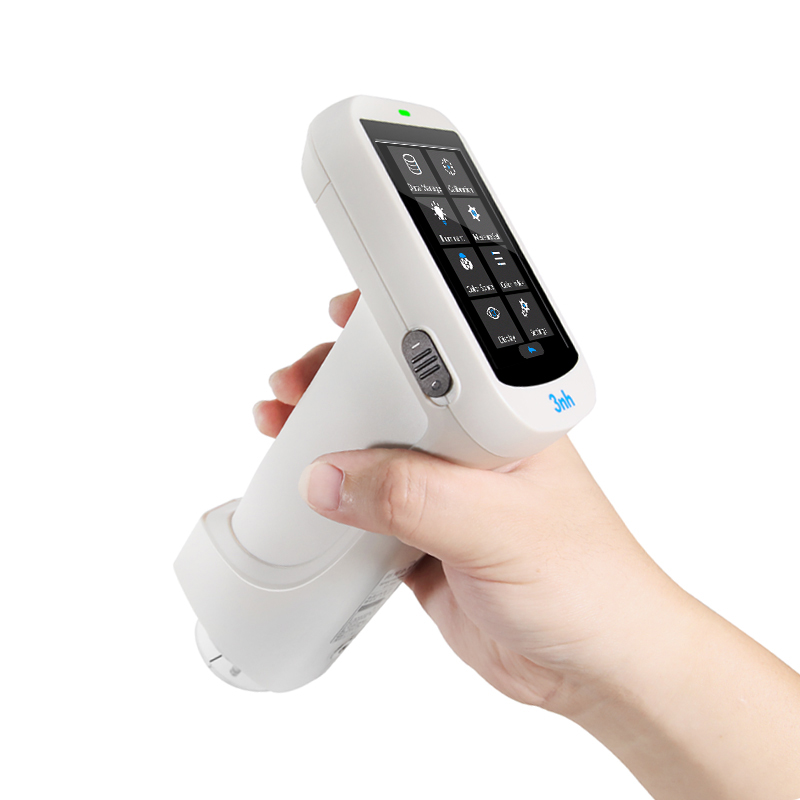
6、 Equipped with three measuring calibers larger to meet the sample measurement needs
The array spectrometer ST2020 is equipped with Φ8mm/φ10mm platform, Φ4mm/φ5mm platform and 1x3mm calibre, which meet the measurement requirements of most special samples.
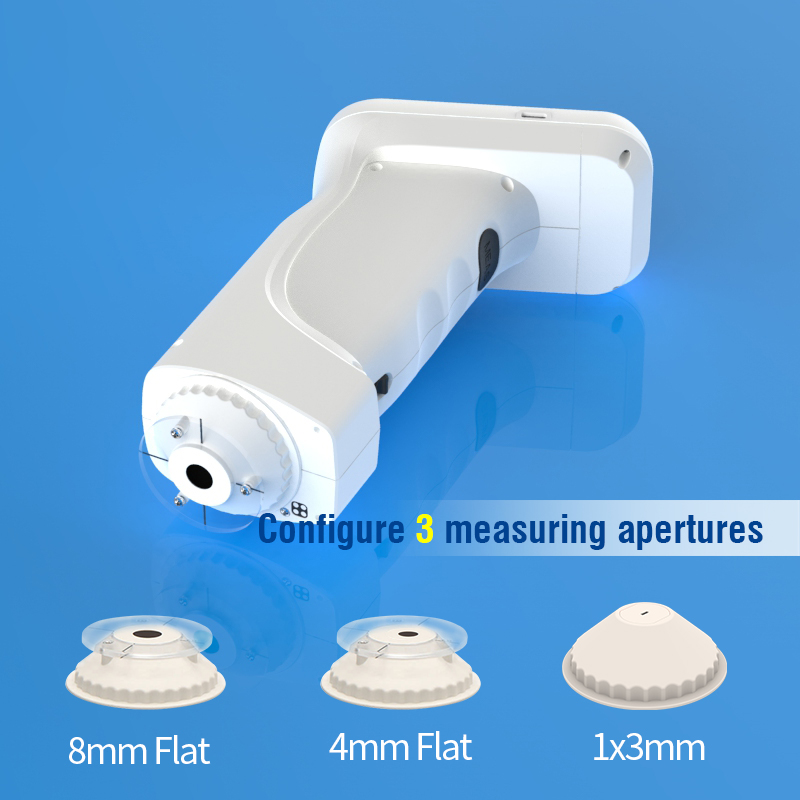
7、Camera positioning can clearly observe the area to be measured
The ST2020 array spectrophotometer has a built-in camera, which can accurately judge whether the object is the target center, and improve the measuring efficiency and accuracy.
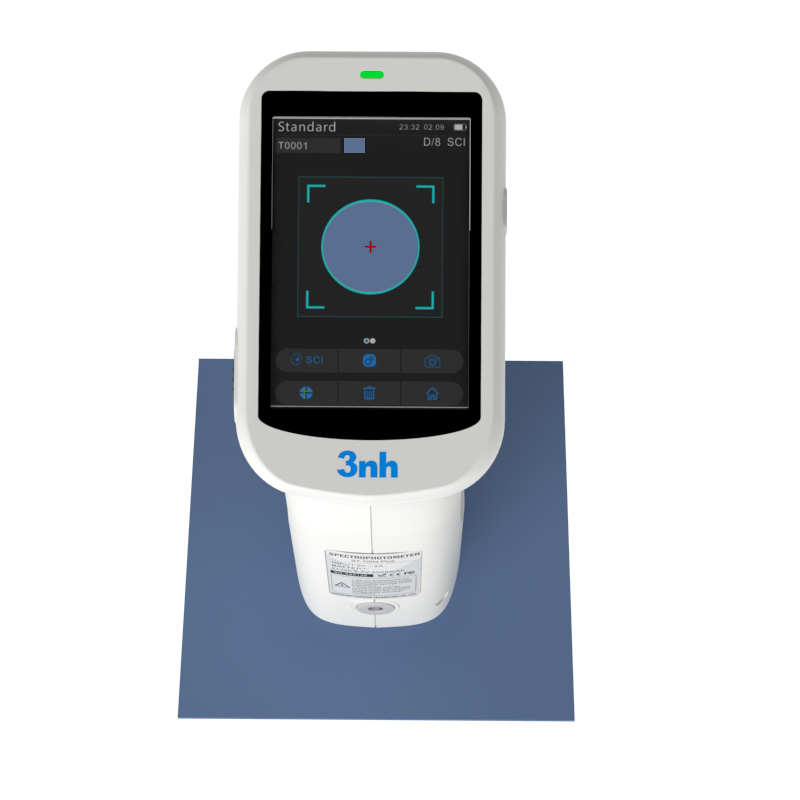
The repeatability ΔE * ab ≤0.028, the Inter-instrument Error ΔE * AB ≤0.28 data is stable and reliable, which ensures the consistency of the data measured by multiple devices, and can be used for color matching and accurate color transfer.
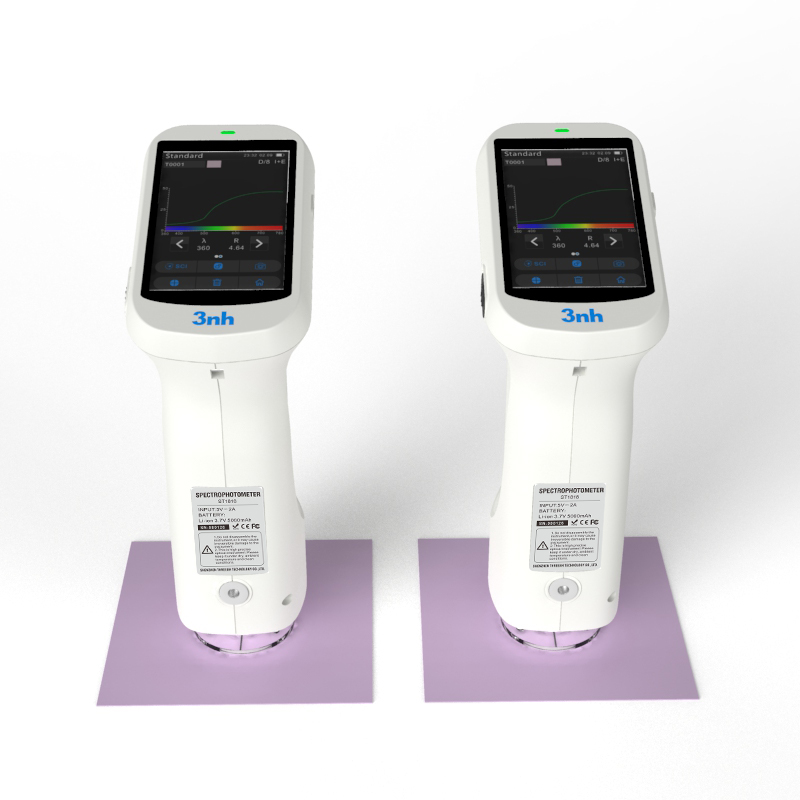
9、Multi-color measurement space and observation light source
Provide CIE LAB, XYZ, Yxy, LCH, Cie Luv, s-RGB, HunterLab, βxy, DIN Lab99 Munsell (C/2) color space, and a variety of observation light sources
A, B, C, D50, D55, D65, D75, F 1, f 2, F 3, F 4, F 5, F 6, F 7, F 8, F 9, F10, F11, F12, CWF, U30, U35, DLF, NBF, TL83, TL84, ID50, ID65, LED-B1, LED-B2, LED-B3, LED-B4, LED-B5, LED-B6, LED-BH1, LED-RGB1, LED-V1, LED-V2, LED-V3, customizable light source, it can meet the special measuring requirements under different measuring conditions.
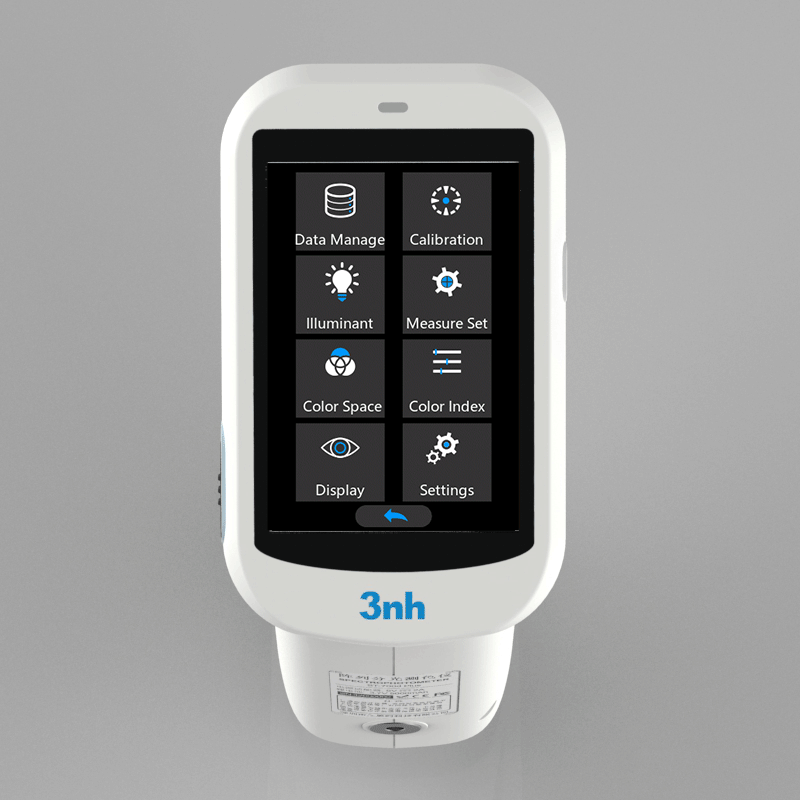
10、Adopt D/8sci/SCE synthesis technology
The measurement structure of D/8(SCI/SCE) is adopted to reflect the color itself more objectively and reduce the influence of the surface texture of the object on the test results, which conforms to the standard CIE No. 15, GB/T 3978, GB 2893, GB/t 18833, ISO7724-1, ASTM E1164, DIN 5033 TEIL7
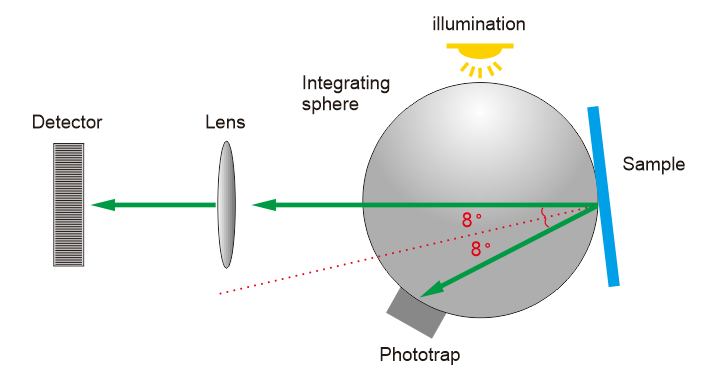
11、Double light path system is more stable in color measurement
Double optical path system, when the environment changes, to ensure that the measurement data more stable and accurate.
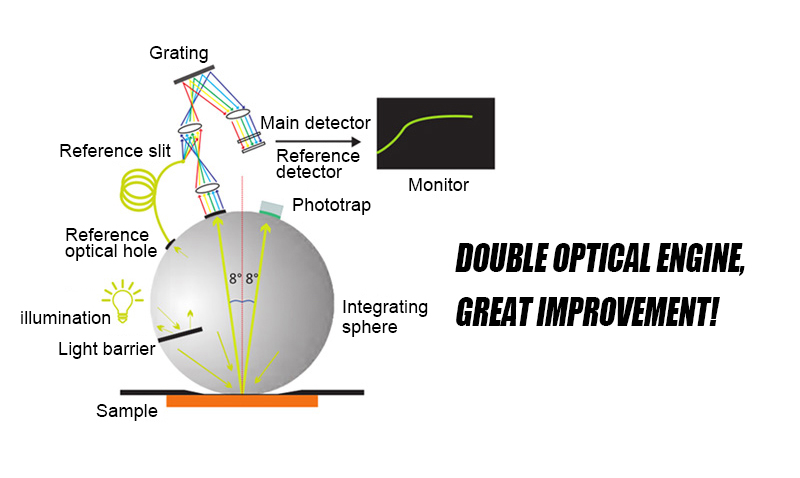
12、Support Android, IOS, Windows, wechat small programs, HUAWEI Harmony OS
The array spectrometer ST2020 is equipped with SQCX software, which is suitable for quality monitoring and color data management in various industries. The user's color management data, compare color differences, generate test reports, provide a variety of color space measurement data, customized customer color management.
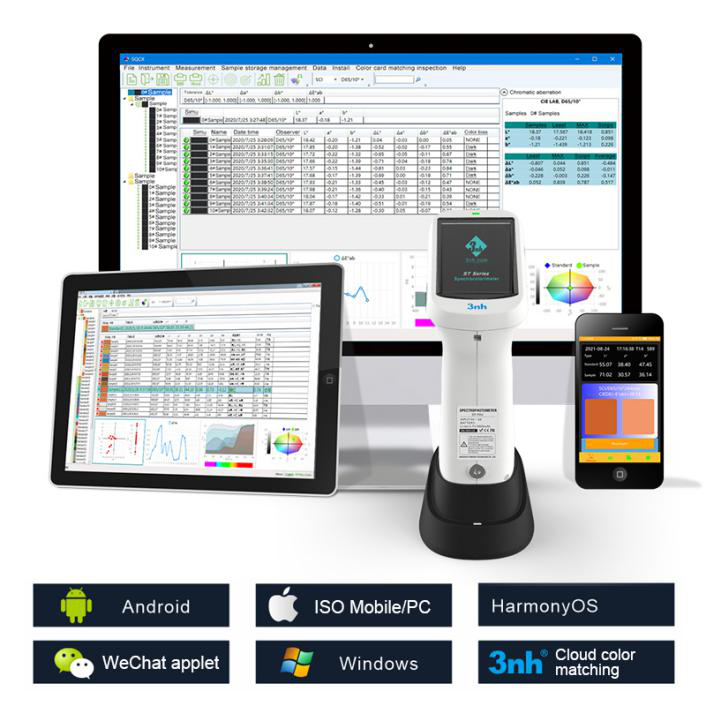
ST2020 technical parameters of the array spectrometer
| Product name | ST2020 array spectrophotometer |
| Optical Geometry | D/8(diffused illumination, 8-degree viewing angle) |
| Specular Component | SCI Including the specular reflection of light |
| Meet The Criteria | CIE NO.15,GB/T 3978,GB 2893,GB/T 18833,ISO7724-1,ASTM E1164,DIN5033 Teil7 |
| Repeatability* | ΔE*ab≤0.028 |
| Inter-instrument Error** | ΔE*ab≤0.28 |
| Displayed Accuracy | 0.01 |
| Measuring/Illuminating Aperture*** |
Dual Apertures:Φ8MM/φ10mm platform + Φ8MM/φ10mm tip +Φ4MM/φ5mm platform+Φ4MM/φ5mm tip+1*3mm |
| Measurement Indicators | Spectral reflectivity, CIE-Lab, CIE-LCh, HunteLab, CIE-Luv, XYZ, Yxy, RGB, chromatic aberration (ΔE * ab, ΔE * CMC, ΔE * 94, ΔE * 00) , whiteness (ASTM E313-00, ASTM E313-73, CIE/ISO, AATCC, Hunter, Taube Berger Stensby) , yellows (ASTM D1925, ASTM E313-00, ASTM E313-73) , blackness (My, DM) , staining fastness, colour changing fastness, tint (ASTM E313-00) , color density CMYK (A, T, E, M) , isochromism index Milm, Munsell, hiding power, force fraction (dye strength, coloring power) |
| Illuminant | A,B,C,D50,D55,D65,D75,F1,F2,F3,F4,F5,F6,F7,F8,F9,F10,F11,F12,CWF,U30,U35,DLF,NBF,TL83,TL84,ID50,ID65,LED-B1,LED-B2,LED-B3,LED-B4,LED-B5,LED-B6,LED-BH1,LED-RGB1,LED-V1,LED-V2,LED-V3,Customisable light sources |
| Displayed Data | Spectrogram/Values, Samples Chromaticity Values, Color Difference Values/Graph, PASS/FAIL Result, Color Simulation, Color Offset |
| Light Source | Combined full spectrum LED light source, UV light source |
| Locating Method | Camera Locating, Stability film, visual |
| Calibration | Intelligent automatic calibration (Contact Type) |
| Accuracy Assurance | Grade I metrological qualification |
| Observer Angle | 2°,10° |
| Integrating Sphere Size | 40mm |
| Spectrophotometric Mode | Flat Grating |
| Sensors | Large-area silicon photodiode array (double-row 20 group) |
| Wavelength Interval | 10nm |
| Wavelength Range | 400-700nm(The user can view 31 wavelengths of reflectivity) |
| Measured Reflectance Range | 0-200% |
| Reflectivity resolution | 0.01% |
| Measurement Mode | Single Measurement, Average Measurement(2-99times) |
| Measuring Time | About 1s |
| Size | L * W * H=114 X 70 X 208mm |
| Weight | About 435g(Calibration block not included) |
| Battery | Li-ion battery, 8500 measurements within 8 hours |
| Illuminant Life Span | 10 years, more than 1.5 million times measurements |
| Display | 3.5-inch TFT color LCD, Capacitive Touch Screen |
| Data Port | USB, Bluetooth 5.0 |
| Data Shorage | Standard 500 Pcs, Sample 20000 Pcs(A single piece of data can include both SCI/SCE) Mass storage on PC/APP side |
| Software Support | Windows, Android, IOS, HUAWEI Harmony OS, We Chat app, Color Cloud APP |
| Language | Simplified Chinese, English, Traditional Chinese |
| Operating Environment | 0~40℃, 0~85%RH (no condensing), Altitude < 2000m |
| Storage Environment | -20~50℃, 0~85%RH (no condensing) |
| Standard Accessory | Power Adapter, USB Cable, User Guide, PC Software(Download from office website), White and Black Calibration Cavity, Protective Cover, Wrist strap, 8mm flat aperture, 4mm tip aperture |
| Optional Accessory | USB Micro Printer, Powder Test Box |
| Notes: * 30 standard deviations of the whiteboard were measured at a 5-second interval after whiteboard calibration; ** BCRA Series II 12-panel measurement average; *** The illumination aperture is the actual aperture size of the instrument; If there are any changes to the above parameters, without prior notice. | |
1. When I received NH310/NH300 colorimeter and perform measurement, why the measured data is abnormal?
After receiving NH310/NH300, you have to perform white and black calibration manually when first starting.
2. In which condition, manual white and black calibration and auto calibration are required for NH310?
a. It’s needed to perform manual calibration for NH310 when first starting.
b. In the subsequent starting, NH310 will perform auto calibration at startup. No need to perform manual calibration.
c. Suggestion: it’s best to perform manual calibration once a week or when NH310 measured data is not accurate.
3. In which condition, manual white and black calibration for NH300 is required?
a. It’s needed to perform manual calibration for NH300 when first starting.
b. In the subsequent starting, no need to perform manual calibration.
c. Suggestion: it’s best to perform manual calibration once a week or when NH300 measured data is not accurate.
4. How to replace NH310 measuring aperture?
There are three measuring apertures for NH310: Φ8mm (standard accessory), Φ4mm (standard accessory), extended Φ8mm (optional accessory)
a. Turning on
b. Removing measuring aperture, install the needed measuring aperture.
c. Select “Settings-Aperture Setting” in main menu to select corresponding measuring aperture.
d. After selecting aperture, the instrument will display “White and Black Calibration” interface. White and black calibration must be performed.
e. Replace completed.
5. CQCS3 (Color Quality Control System) Installation
a. Before installation, please Copy CQCS3 folder to your computer and don’t remove any files in CQCS3 folder.
b. Double-click the setup.exe to install CQCS3 software.
c. Then double-click Install.bat under the CQCS3\USB_Driver file to install the driver.
d. Detailed installation information please read the "Installing Software" under CQCS3 User manual.doc.
6. How to check communication port?
a. Connect colorimeter to the PC with USB cable.
b. Turn on the colorimeter to enter main menu. Select “Comm” and press “Enter” key to start communication.
c. Right click on “My Computer” on the desktop. Click “Manage” -> “Device Manager” -> “Ports”, you can see similar display as “SCI USB2Serial (COM6)”.
d. Click “Settings->Communication Parameters” in CQCS3 software interface. Select the corresponding port in “Serial Port”.
7. After completing CQCS3 installation, how to solve the problem if it display “! USB Device” or “! SCI USB2Serial (COM6)” when checking the communication port?
a. Right click “! USB Device” or “! SCI USB2Serial (COM6)”, “Update Driver” -> “Install from a list or specific location (Advanced)” -> “Next” ->“Include this location in the search” -> “Browse”, specify USB driver file path “CQCS3\USB_Driver”, click “Next”. Then it will install successfully.
b.Detailed installation information please refers to “2.2 Installing USB Driver” in Color Quality Management System User Manual.doc.
8. Notes for First Using CQCS3 Software
a. Users must specify Standard File Name, Sample File Name and Sample Database File Name when first use.
b.Standard File is use to store standard measurement data. Sample File is used to store sample measurement data. Sample Database File is used to store the measured data exported from sample records.
9. How to solve the problem when “Connection Timeout” occurred?
a. When the colorimeter is disconnected to the PC, “Connection Timeout” will occur. At the moment, you have to check whether the USB cable is well connected the colorimeter and the PC. Then you can re-plug the USB to try out.
b. After ensuring the colorimeter is connected to the PC with USB cable, turn on the colorimeter and enter the main menu. Select “Comm” and press “Enter” key to start communication.
c. Turn off CQCS3 software, and reopen it.
10. How to solve the problem when the interface display "USB Disconnect"
a. Check whether the USB cable is connected. If not, please connect it. Check whether the connection is effective. You can re-plug the USB cable to test.
b. If the USB cable is connected well but the interface still displays "USB Disconnect", please re-start the colorimeter and enter "Menu" -"Comm"to start the communication.
c. Change the USB cable or change the USB port in you PC.
11. How to solve the problem when the colorimeter cannot be turned on in the condition of battery-powered?
a. If this phenomenon occurred, it means the battery power is not enough. You need to charge the battery.
b. When charge the battery, please insert the battery to the instrument, and plug in the adapter to charge the battery. After 5 minutes, the instrument can be turned on.
c. If the instrument still cannot be turned on after charging 5 minutes, you can pull out the adapter and re-plug in to check it. Or repeat this operation.
d. If the instrument still cannot be turned on after charging 5 minutes, you can turn off the colorimeter and turn on it again to check it. Or repeat this operation.
e. If you have tried all the methods above but the colorimeter still cannot be turned on, please change the battery.